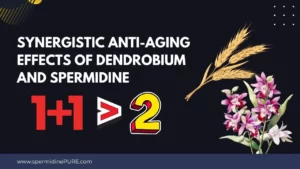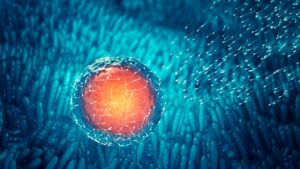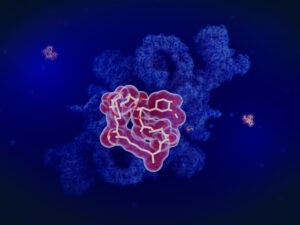Specific therapies with natural ingredients like NMN or spermidine have been proven to increase longevity or improve healthspan in animal models and even in human trials. Proteins from the sirtuin family are one of the most promising agents for anti-aging treatments. In humans, there are seven in the family (SIRT1-7). SIRT6 is among the other family groups that have been considered a protein of aging. SIRT6 engages in a number of cellular signaling pathways, from DNA damage repair in the early stages and enzymatic activities to disease development. SIRT6 has many biological rules and exerts its action through several pathways in cells and molecules, which we will focus on in this article.
Structural characteristics and enzymatic activities of SIRT6
SIRT6 can participate in three separate enzymatic activities with various substrates, making it difficult to characterize its molecular actions.
Structural characteristics
The Rossmann fold subdomain of SIRT6 has the ability to bind NAD+, just like many other Sirtuins stably. SIRT6’s unique NAD+ binding structure may have a higher affinity for NAD+ binding than other family members. The tiny and splayed zinc-binding module, which is regulated by SIRT6 Cys141, Cys144, Cys166, and Cys177, has a strictly structural function. Moreover, between the Rossmann and Zn2+ subdomains of SIRT6, a longer active site is also discovered, the biggest hydrophobic channel binding pocket in the Sirtuins family and may help explain why SIRT6 prefers long-chain fatty acylation over acetylation in vitro experiments.
Enzymatic activities
To activate SIRT6 deacetylase activity in vitro, a number of unique long-chain fatty FAs can bind together. SIRT6’s hydrophobic pocket is where FAs interact to cause conformational changes in SIRT6 that improve the enzyme’s affinity for acetylated substrates. It has been demonstrated that a variety of stress factors can precisely regulate SIRT6 abundance and enzymatic activity.
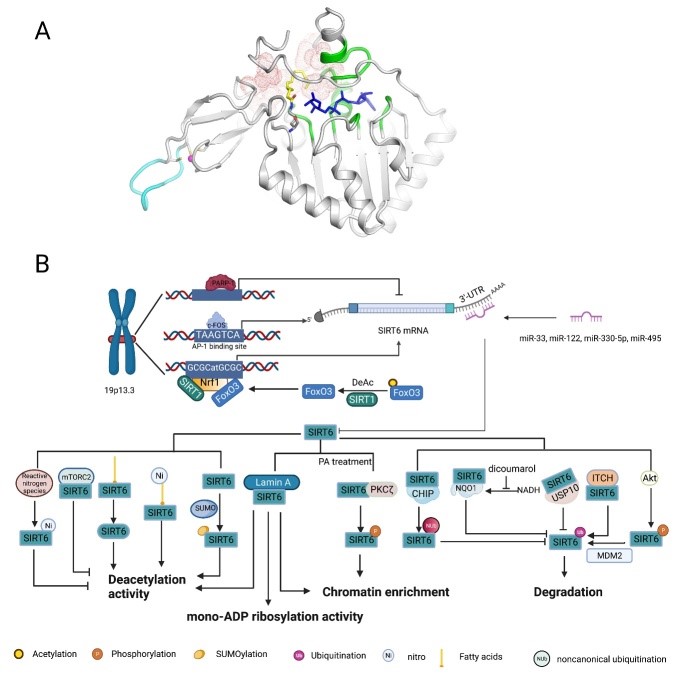
Guo, Z., Li, P., Ge, J., & Li, H. (2022). SIRT6 in Aging, Metabolism, Inflammation and Cardiovascular Diseases. Aging and Disease, 13(6), 1787-1822. https://doi.org/10.14336/AD.2022.0413
(The structural features of SIRT6.)
Biological characteristics of SIRT 1
SIRT6 has a variety of biological roles, but the most important one is that it controls cell aging and lifespan. The significance of SIRT6 in DNA repair, reducing stress and inflammation, maintaining oxidative homeostasis, and controlling metabolic balance emphasizes this protein’s significant therapeutic promise in aging and age-related diseases.
SIRT6 slows down aging by preserving genome stability
Cellular senescence continues to be a significant risk factor for age-related disorders. The study discovered that older mammals are more vulnerable to DNA damage than younger mammals, speeding up the process of DNA damage in the future. SIRT6 maintains genome integrity in several ways to prevent cell aging.
SIRT6 suppresses LINE1-induced genomic damage and maintains telomere integrity
The only transposable element with the ability for autonomous retrotransposition is LINE1. By its mono-ADP-ribosyltransferase activity, SIRT6 stops the LINE1 retrotransposon.
Telomere damage suppresses the expression of Sirtuins, particularly SIRT6. The production of SIRT6 is strongly linked to the preservation of telomere integrity and can stabilize telomere chromatin and other vital molecules, thus maintaining DNA integrity.
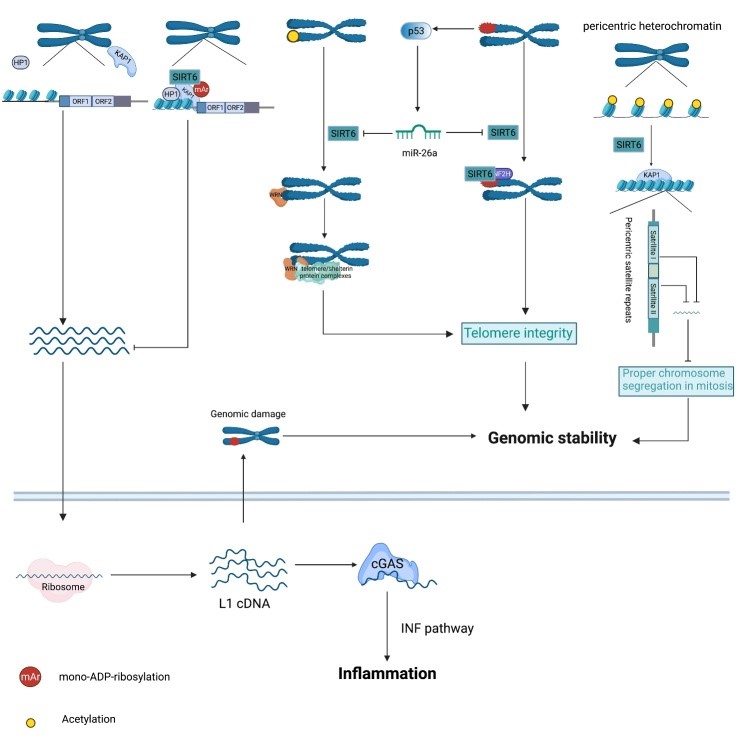
Guo, Z., Li, P., Ge, J., & Li, H. (2022). SIRT6 in Aging, Metabolism, Inflammation and Cardiovascular Diseases. Aging and Disease, 13(6), 1787-1822. https://doi.org/10.14336/AD.2022.0413
(SIRT6 suppresses LINE1-induced genomic damage.)
SIRT6 helps in DNA repair
Current research improvements have highlighted SIRT6’s numerous roles in DNA double-strand break (DSB) repair, clip excision repair (BER), and nucleotide excision repair (NER). By changing histones, cells can react to DNA repair procedures more quickly and effectively.
SIRT6 reduces stress and inflammation
Earlier studies have shown that oxidative stress can cause reduced SIRT6 activity. Also, oxidative stress causes inflammation in cells and tissues. To raise cellular NAD+ and NADPH levels and protect from oxidative stress, SIRT6 directly deacetylates NAMPT. Inflammation is a direct response to damage, whether it is caused by oxidative stress or other injuries. Recent research revealed that TNF- and NF-kB expression or other protein functions were crucial for SIRT6’s functions in controlling anti-inflammatory responses. Nonetheless, targeting SIRT6 is a sensible therapeutic approach due to the complex functions that SIRT6 plays in oxidative stress and inflammation.
Among many processes that can be enhanced with SIRT6, SIRT6 also maintains homeostasis by regulating glucose, fat levels, and other parameters. In one study, glucose metabolism is also improved in SIRT6-mice by several processes, including glucogen synthesis, insulin sensitivity, and more.
SIRT6 improves cardiovascular disease
Cardiovascular disease (CVD) is the most frequent cause of death linked to aging. Studies discovered that SIRT6 could help in many CVD conditions, including atherosclerosis, cardiac hypertrophy and fibrosis, heart failure, and ischemia/reperfusion.
Atherosclerosis
SIRT6, the protector of genome stability, can stop premature vascular aging and maintain normal vascular endothelium function by preserving endothelial cells from DNA and telomere damage. In addition, by protecting blood lipid homeostasis, SIRT6 acts as a preventive measure against atherosclerosis by speeding up the elimination of serum triglycerides and LDL-C.
Heart failure
Abnormalities of energy metabolism in cardiomyocytes, including reduced mitochondrial oxidation capacity, excessive substrate buildup, and poor utilization of intermediates, are the leading pathogenic cause of heart failure. SIRT6 can improve cardiac function by controlling lipid metabolism and glucose oxidation, thus retaining the cardiomyocytes’ energy source.
Cardiac hypertrophy and cardiac ischemia
SIRT6 reduces oxidative stress and apoptosis to minimize injury in the heart and brain. In addition, SIRT6 acts with Sp1 to block mTOR signaling and protein synthesis and prevent abnormal cardiac growth, leading to heart failure.
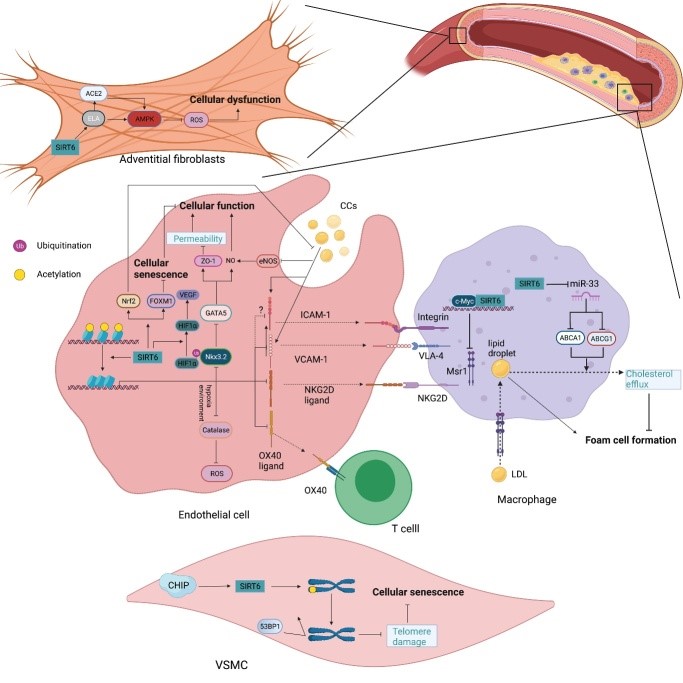
Guo, Z., Li, P., Ge, J., & Li, H. (2022). SIRT6 in Aging, Metabolism, Inflammation and Cardiovascular Diseases. Aging and Disease, 13(6), 1787-1822. https://doi.org/10.14336/AD.2022.0413
(SIRT6 plays a role in vascular atherosclerosis.)
SIRT6 modulators
According to many previous investigations, SIRT6 is crucial in cardiovascular disease, inflammation, and many other diseases linked to aging. That’s why SIRT6 modulators may have therapeutic advantages.
First, it has been demonstrated that various natural plant extracts can modify SIRT6 expression or activity. For instance, recent research has revealed that the polyphenols quercetin and icariin also enhance SIRT6 deacetylation activity. In addition to therapeutic medications that have been demonstrated to modify SIRT6 to have protective effects, many synthetic chemical compounds have been produced to activate SIRT6 as well as certain drugs. On the other hand, certain SIRT6 inhibitors reduce SIRT6 deacetylase activity.
Conclusion
The understanding of SIRT6 expression and function is key to improve certain diseases. Therefore, the whole investigation and deep understanding of SIRT6 can contribute to better aging. In addition, the SIRT6 modulators need to be considered further in order to be used as therapeutical agents, which according to studies, offer promising therapeutic options for aging-related diseases.
References
- Guo, Z., Li, P., Ge, J., & Li, H. (2022). SIRT6 in Aging, Metabolism, Inflammation and Cardiovascular Diseases. Aging and Disease, 13(6), 1787-1822. https://doi.org/10.14336/AD.2022.0413

